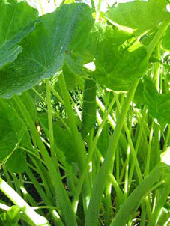| Organic Seeds | Edible Plants | Organic Pest Controls | Books | Tools, Propagation & Fertilisers | Sprouting & Microgreens | Poultry Supplies | Specials & Gift Ideas |

Top

We will send an email to this address*
when is next available
* we will use this email address only for this notification and then we will delete it.
 Home
Home
Green Harvest Organic Gardening Supplies is permanently closed as of 5pm on 1-11-2023.
We will not be taking orders by this website, in person, by phone or email. Our display garden and retail shop are closed forever.
Read more...
Phone:07 54357000
Phone calls will only be responded to sporadically and only in reference to orders placed prior to 2-11-2023. All the useful growing and organic pest management research and resources are available on this website for a while still.
 AVAILABLE FOR PURCHASE:
buy or get emailed when available
AVAILABLE FOR PURCHASE:
buy or get emailed when availableTAHITIAN SPINACH GROWING INFORMATION
© Frances and Jeff Michaels
BOTANICAL NAME:Alocasia esculenta syn. Colocasia esculenta
COMMON NAMES: Tahitian Spinach; Celery Stem Taro
FAMILY: Araceae
PLANT DESCRIPTION
Native to Indo-Malaysia and the Pacific, taro is widely grown throughout the tropics for its edible corms and stems. This particular taro was developed for its yield of edible leaves and stems rather than its roots. Taros are adapted to flooded environments and, like rice, can be grown in paddy culture. Under paddy they are grown in all soil types. They can also be grown in dry, upland areas if water is provided by irrigation or rainfall, mulching helps. Grown 'dry' the best results are obtained on deep, well-drained friable loams.
USES
Food: the leaves and leaf stems are eaten as a cooked, green vegetable; the stems are widely used as a celery substitute in tropical areas. Taro should never be eaten raw. They provide protein, calcium, phosphorus, iron, potassium and vitamins A, B, and C. The leaves can be harvested all year round.
PLANTING DETAILS
Recommended planting time: Plant any time that the soil is warm and rain is expected.
Planting depth: Plant the tuber a few cm below the soil surface.
Plant spacing: 60 - 90 cm apart.
Growing details: Taro is propagated vegetatively, by the leaf-bearing tops of mature corms or by small side shoots or suckers. Tahitian Spinach is prone to producing heaps of small bulbils that, if disturbed, can spread rapidly. It tends to be hard to clear out of an area because of the sheer numbers of these small bulbils. So it is best planted off in a corner, where it can be left undisturbed.
Taro 'Chinese' is another type of Taro used for its roots (tubers).
Not to NORFOLK ISLAND, NT, SA, TAS or WA
SORRY but due to quarantine restrictions between Australian States no plants at all can be ordered by residents of Norfolk Island, Tasmania and Western Australia. These restrictions are very important as they prevent the spread of plant pests and diseases. No potatoes, garlic, shallots, strawberries or tubestock can be sent to South Australia. No tubestock can be sent to Northern Territory.
 Home
Home
Green Harvest Organic Gardening Supplies is permanently closed as of 5pm on 1-11-2023.
We will not be taking orders by this website, in person, by phone or email. Our display garden and retail shop are closed forever.
Read more...
Phone:07 54357000
Phone calls will only be responded to sporadically and only in reference to orders placed prior to 2-11-2023. All the useful growing and organic pest management research and resources are available on this website for a while still.
DISCLAIMER:
No liability will be accepted by Green Harvest, its owners or employees as to the accuracy of any information. No responsibility will be taken for damage to property or persons due to information given about a product or technique. No responsibility will be taken for the loss of a crop or income due to information given about a product or technique.
 Shopping here is private and secure.
Shopping here is private and secure.
Copyright © 2001 - 2024 Green Harvest Organic Gardening Supplies
No part of this website may be reproduced without permission of the owner
SORRY but due to quarantine restrictions between Australian States no plants at all can be ordered by residents of Norfolk Island, Tasmania and Western Australia. These restrictions are very important as they prevent the spread of plant pests and diseases. No potatoes, garlic, shallots, strawberries or tubestock can be sent to South Australia. No tubestock can be sent to Northern Territory.
 Home
Home
Green Harvest Organic Gardening Supplies is permanently closed as of 5pm on 1-11-2023.
We will not be taking orders by this website, in person, by phone or email. Our display garden and retail shop are closed forever.
Read more...
Phone:07 54357000
Phone calls will only be responded to sporadically and only in reference to orders placed prior to 2-11-2023. All the useful growing and organic pest management research and resources are available on this website for a while still.
No liability will be accepted by Green Harvest, its owners or employees as to the accuracy of any information. No responsibility will be taken for damage to property or persons due to information given about a product or technique. No responsibility will be taken for the loss of a crop or income due to information given about a product or technique.
 Shopping here is private and secure.
Shopping here is private and secure.
Copyright © 2001 - 2024 Green Harvest Organic Gardening Supplies
No part of this website may be reproduced without permission of the owner